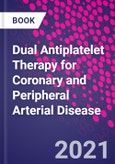Dual Antiplatelet Therapy for Coronary and Peripheral Arterial Disease is a complete reference containing updated information on the advantages and disadvantages of dual antiplatelet therapy, its duration, composition and anticipated changes. The basis for DAPT in arterial disease is discussed, allowing readers to understand platelet physiology and its relevance to ischemic events. Data on shorter than usual duration of DAPT, and on extended therapy beyond the recommendation of current guidelines is presented in great detail, summarizing a large body of evidence into concrete, relevant recommendation that is readily adaptable by practicing clinicians.
A clinically relevant and updated compendium of data pertaining to this field is also presented, as well as the anticipated trends and innovations likely to occur in the next 3-5 years.
Please Note: This is an On Demand product, delivery may take up to 11 working days after payment has been received.
Table of Contents
- Platelets and arterial disease
initiation, progression and destabilization of atherosclerotic vascular disease
- Platelet physiology and pharmacology
relevant considerations for patient care
- The development of dual antiplatelet therapy
physiologic and clinical implications of multiple pathway inhibition of platelet function
- Acute coronary syndromes and percutaneous coronary intervention
current recommendations for dual antiplatelet therapy. Are guidelines reflecting the data?
- Peripheral arterial disease
a different kind of arterial disease? The role of antiplatelet therapy in prevention and treatment of limb ischemia
- Cerebrovascular disease
what is the role of DAPT for prevention and treatment of ischemic stroke?
- Competing risks in DAPT duration of therapy
the case for shorter treatment
- DAPT may prevent coronary ischemic events beyond one year
the case for extended DAPT treatment
- How to integrate risk of bleeding and ischemic events in clinical medicine? The role of risk scores
- Moving from DAPT to monotherapy based on P2Y12 receptor blockade
why it could be a novel paradigm?
- The conundrum of simultaneous antiplatelet and antithrombotic therapy
how to resolve it?
- A look to the future








